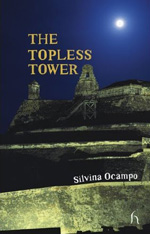

Hesperus Press, paperback, 9781843918554
Little Leandro, nine, having displeased a gentleman visitor who may be the Devil, finds himself a prisoner in the tower which gives this story its title. He discovers a room set up with all the requisites a painter could need. He begins to paint.
Hoping to paint his mother, but lacking the skill to render her correctly, he instead paints other things, some welcome, others not. He finds that the things he paints can come out of their paintings and join him in the tower. He tries to paint his way out of captivity and back to his mother.
That's a short synopsis of a short book—a novella of 15,000 or so words, attractively presented by Hesperus Press and smoothly translated from the original Spanish, as best I can judge, by James Womack.
The author, Silvina Ocampo, has had the misfortune to be remembered more for the famous members of her circle than for her own writing. Her sister, Victoria Ocampo, was a major figure of Argentine letters: writer, critic, and editor of the renowned literary magazine Sur. Silvina Ocampo's husband, Adolfo Bioy Casares, was a considerable author in his own right, and is himself best known for his frequent collaborations with Jorge Luis Borges, a figure large enough to cast a long shadow over many contemporaries.
But Silvina Ocampo's own achievement does not deserve to be forgotten. She published several volumes each of short stories and poetry, won the Argentine National Prize for Poetry in 1962, and became well known in particular for her children's stories.
With its nine-year-old protagonist, industriously underlining words he does understand, The Topless Tower may look like a children's story, but it seems to me more like a story about a child told for adults' benefit. If I had to pick a theme, though—a dangerous exercise, bringing to mind the terrors of sixth-form English essays—it would be that of creativity in general and painting in particular. Leandro's ability to influence the world he is trapped in and his chance of escape both come from painting, and the chief obstacle to the realization of his desires is his inability to put down on canvas what he sees in his mind's eye.
Having set up its scenario briskly, The Topless Tower unfolds with the slightly addled logic of a
daydream. Perhaps the very end of the story is a little heavy-handed in Leandro's recounting of the lessons
he has learned; apart from that, if you are prepared to allow a little magic in your realism, there is a great
deal of enjoyment to be had from this fleet-footed story, with its young love, its faithful dog, its easily
offended Devil, and its plucky young hero who paints his way out of a tight corner.
